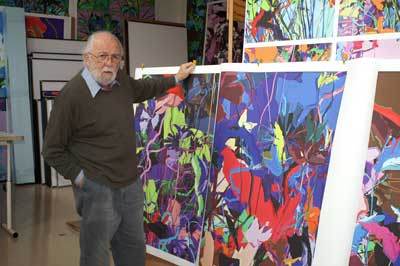
AARON is software program that, more or less autonomously, creates original art. It is the brain child of computer programmer and artist Harold Cohen. Cohen started this project, which has been in continuous development since 1973, by asking the question "What are the minimum conditions under which a set of marks functions as an image?"
AARON's art has developed significantly since its early development. It initially created abstract black and white drawings, moving to more representational black and white imagery in the 1980's (including plants and people, and eventually interior scenes). Cohen, who had been coloring in the black and white images by hand, eventually ran into the dilemma that if he was trying to further this computer program in autonomously creating art, he could not continue to do the coloring himself. Yet, despite a switch to a more expressive computer program and script, Cohen faced the issue of how to add color to the program code.
In Chapter 2 of his Creative Minds, Howard Gardner defines the creative individual as "a person who regularly solves problems, fashions products, or defines new questions in a domain in a way that is initially considered novel but that ultimately becomes accepted in a particular cultural setting." Cohen himself certainly fits this definition. He explains his problem solving technique and the eventual need for divergent thinking in a lecture for Tate Gallery titled "A Sorcerer's Apprentice"; "Wearing first one hat and then the other [of engineer and expert], I would approach each problem about how to have the computer do something by asking how I would do it myself. And it worked, until I confronted the problem of color and found that I didn’t know how I used color myself." He notes that the human mind works with color by a constant series of visual feedback, adding more or less of what it needs depending on the visual hue as the colorist is mixing. A computer, on the other hand, has the ability to manipulate complex internal representations in a way that the human brain cannot. So, Cohen realized that if he could create a goal for coloring, and articulate rules for reaching that goal, then the computer should be able to create this color "in its head," without ever needing the intermediate results that humans do.

The capacity of AARON to produce a practically infinite supply of distinct images on its own its pretty remarkable, but can we then say that AARON itself is creative? Gardner would argue no, arguing that "by insisting that creativity can involve the fashioning of products or the devising of new questions, [he] challenge[s] psychometric and computer simulation approaches, which prove far better at resolving extant problems than at forging new products or at defining new problems" (Gardner, Ch. 2). While it's true that AARON can't learn new styles or imagery on its own, and it could be argued that Cohen is the real artist who is just giving AARON procedural instructions, AARON is still producing products that Cohen would otherwise have been unable to. Cohen has been careful not to call AARON "creative," but he does ask "If what AARON is making is not art, what is it exactly, and in what ways, other than its origin, does it differ from the 'real thing?' If it is not thinking, what exactly is it doing?"

In the same lecture at Tate Gallery, Cohen notes "I can hardly expect AARON suddenly to come up with images for which I have absolutely no responsibility. But there’s no question that it makes images I couldn’t have made myself by any other means. And if I look at the images in detail I find lots of things happening that I would never have imagined, let alone programmed for. So, even at this early stage, AARON is exhibiting the property of emergence, which may reasonably be regarded as a requirement for autonomous creative behavior."
AARON's ability to produce beyond the capacity of its creator calls into question the definition of creativity as we know it, bringing forth the question of whether we, as humans, are a necessary component of the creative process at all.
Sources:
http://aaronshome.com/aaron/index.html
Cohen, Harold. ""A Sorcerer's Apprentice" Talk at the Tate Modern". aaronshome.com.
No comments:
Post a Comment
Note: Only a member of this blog may post a comment.